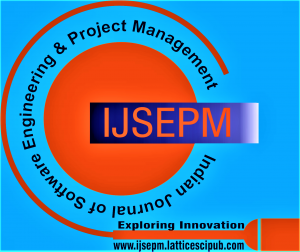Correction, Retraction, and Post Publication:
Correction:
If an error is found in an article that could affect its interpretation, but the article’s scholarly integrity will not compromise, the Indian Journal of Software Engineering and Project Management (IJSEPM) will issue a correction that includes mistakes such as mislabeling a figure or omitting essential information about funding or competing interests of the authors1.
The article in both HTML and PDF versions will undoubtedly showcase the Crossmark button, which grants readers swift and effortless access to the present condition of a content item, including any correction or retraction made to that particular record.
If an error is found in the article, a correction notice will be issued to ensure its integrity. The Crossmark button will show any updates made to the content, including corrections or retractions. Retraction notices may be issued for unresolved serious issues1,2.
- Error Made by Author:
Authors can request corrections to their published articles if critical errors affect scientific integrity, reputation, or the journal. Corresponding authors should contact the chief editor to rectify the mistake2.
- Errors/missing data: Yes, it is possible.
- Request to remove/add the author’s name:
The Indian Journal of Software Engineering and Project Management (IJSEPM) will correct errors in the original PDF and HTML versions if errors are found in published articles. It will also provide an amendment notice with bi-directional links to and from the corrected article, including any changes made to data in figures, tables, or text. If the error is in an old article, provide links to the amendment notice but cannot change the original.
- Error Made by Publisher:
Suppose a scientific article contains vital errors that affect its integrity, publication record or the reputation of the authors or the journal. In that case, it may be necessary for a correction to be published by the publisher.
Supplement:
A supplement is usually released when extra information is crucial for the reader’s comprehension of the article, which was unavailable at publication.
Editor Notes:
Editors can issue notes to alert readers to severe issues affecting a published article’s integrity. These statements are published online, linked to the original article with a DOI, and included in major scholarly databases (e.g., PubMed, Scopus, WoS)4.
The Indian Journal of Software Engineering and Project Management (IJSEPM) can take down an article from its online platform. Such an action is only taken in rare circumstances where a correction notice isn’t sufficient to address substantial issues. If the need arises, this step will be taken following the guidelines described below3,4.
- Content may need to be removed if a court or government order has been issued or is expected to be published.
- If it violates the legal rights of a third party, such as their intellectual property or privacy, or is otherwise illegal.
- If the content is acted upon, it would present a significant and immediate danger to one’s health.
Content can be removed either temporarily or permanently. However, bibliographic metadata, such as the author’s names and titles, will still be available and will come with a statement explaining the reason for the removal. If a decision has been made to retract an article, then…:
- a published version (HTML and PDF) of the article includes a “retracted” watermark on the record.
- a distinct statement labelled ‘Retraction: [article title]’ is released to retract an article from the journal. This statement must be linked to the retracted article to ensure accuracy and clarity.
- the retraction statement is accessible in the journal.
Post Publication:
Any article adjustments will accompany a formal correction or retraction notice in cases requiring post-publication corrections or retractions. This notice will meticulously delineate the specific inaccuracies within the article and detail the comprehensive scope of the corrections applied. The notice will provide the rationale underpinning these actions for retractions or removals, ensuring transparency in the correction process5.
References:
- International Committee of Medical Journal Editors (ICMJE) – Corrections, Retractions, Republications and Version Control
- COPE- Retraction or correction
- WAME – Responding to Allegations of Possible Misconduct
- ORI – Handling Misconduct – Inquiry & Investigation Issues
- Publication Ethics: Journal Options for Post-Publication Discussions and Corrections
- Adheres to the Editorial and Publishing Policies of Lattice Science and Publication (LSP)
